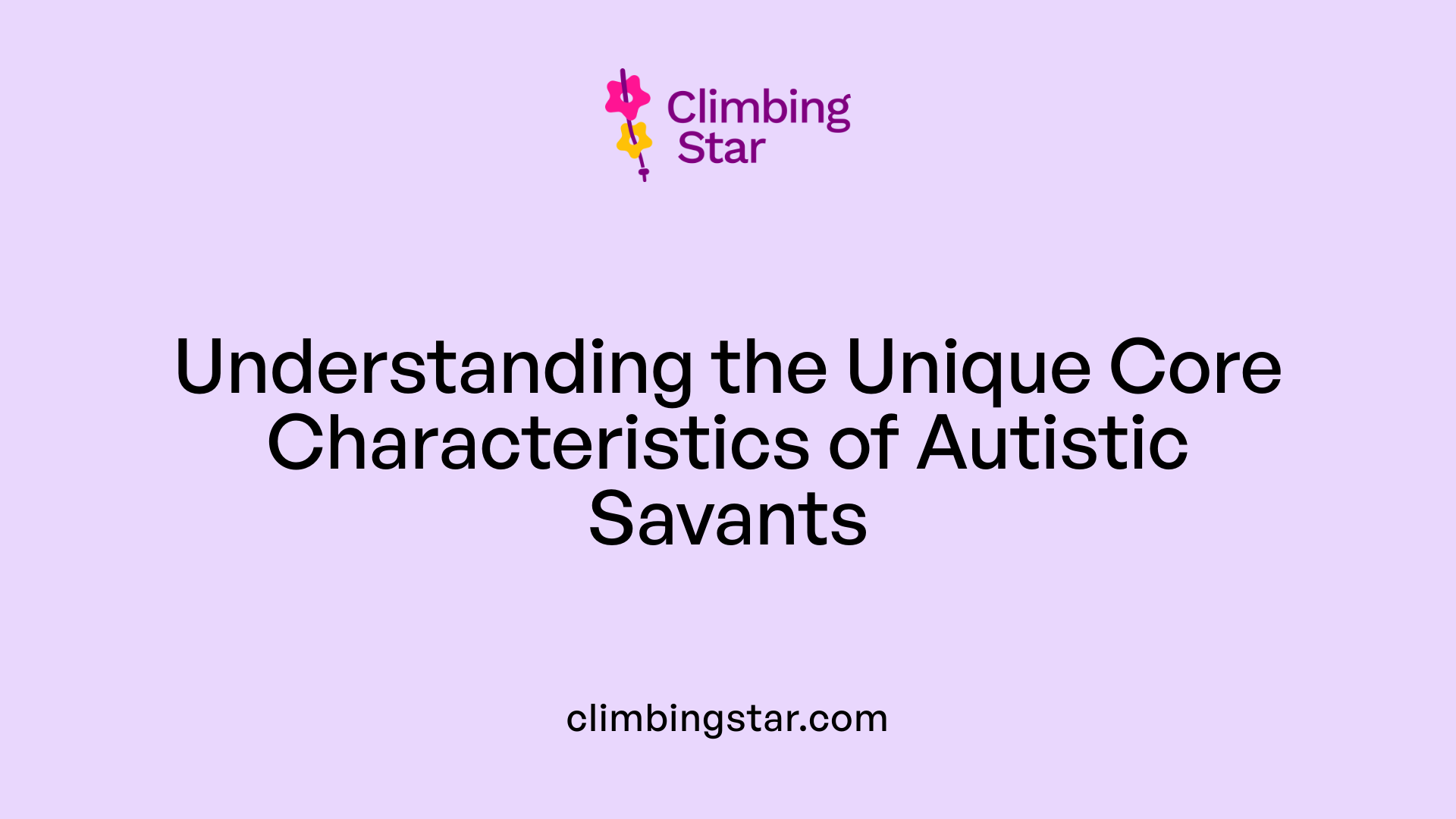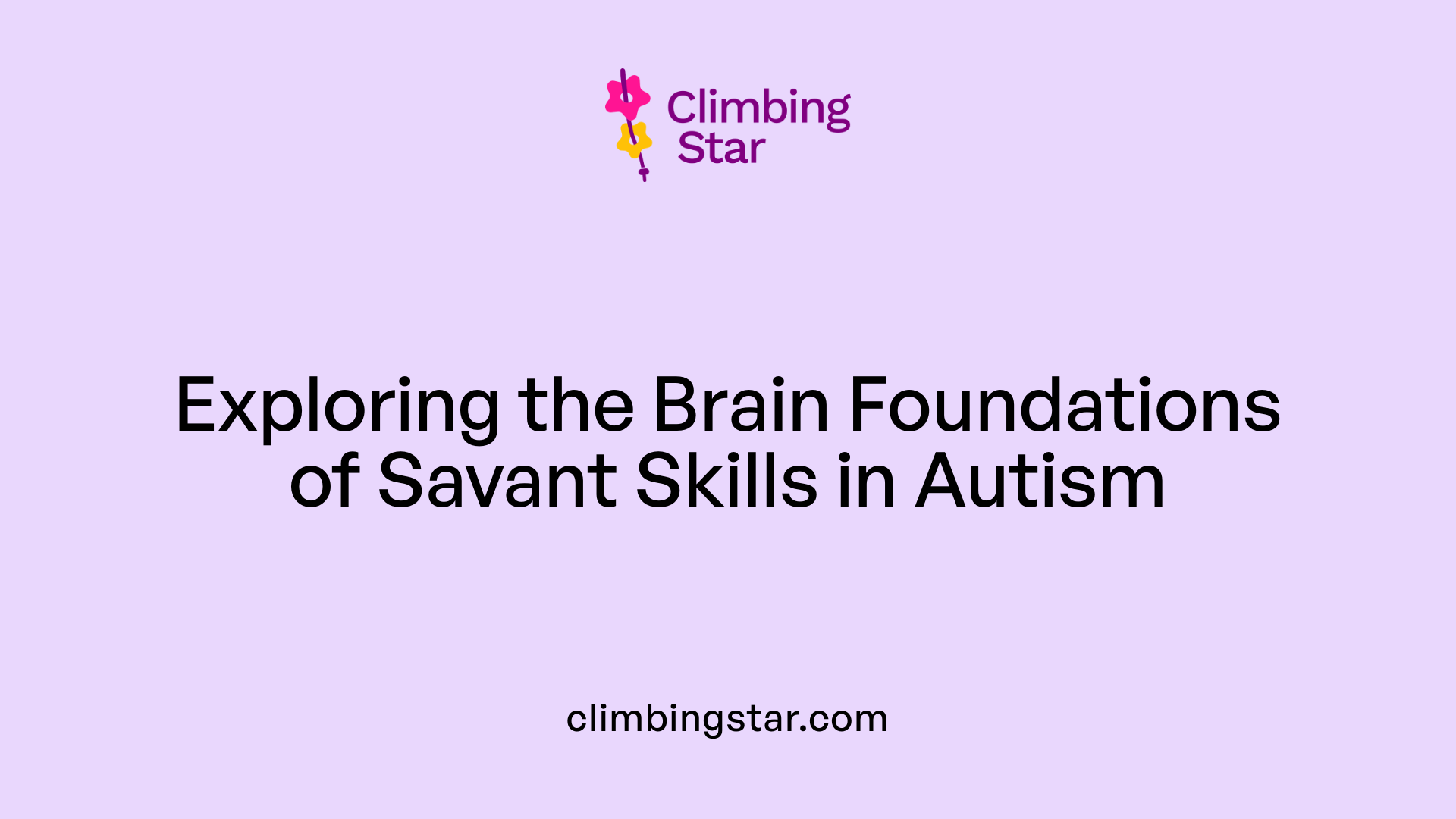Journey into the World of Remarkable Abilities
Autistic savants represent a fascinating intersection of neurodevelopmental challenges and extraordinary talents. This article explores the defining features, neurological underpinnings, notable examples, diagnostic insights, and support strategies for these remarkable individuals, shedding light on how talent and adversity coexist in the realm of autism.
Defining Autistic Savant and Core Characteristics

What is savant syndrome and how is it related to autism?
Savant syndrome is a rare and fascinating condition where individuals display exceptional talents or skills in specific areas such as music, art, math, or memory. These extraordinary abilities often contrast sharply with the person's overall cognitive or social functioning, highlighting a unique divergence in brain capacity.
Most cases of savant syndrome are linked to autism spectrum disorder (ASD). In fact, about half of all savants are autistic, making the connection between the two conditions particularly significant. Autistic savants exhibit remarkable skills that can be congenital or develop after brain injury, illustrating the brain's plasticity and diverse capabilities.
Research suggests that the neurological basis involves hemispheric asymmetry, particularly with dysfunction in the left hemisphere and compensation by the right hemisphere. This imbalance can foster heightened perceptual and pattern recognition abilities.
While not classified as a formal disorder, savant syndrome is viewed as a spectrum of talents co-occurring with neurodevelopmental conditions. Individuals with these skills often possess extraordinary memory, perception, and pattern recognition abilities.
The relationship with autism is crucial because many autistic individuals exhibit savant skills, which offer insights into brain function. These talents can sometimes serve as strengths, helping individuals with autism lead more successful lives.
What are common skills or talents of autistic savants?
Autistic savants frequently possess extraordinary skills in areas such as music, art, memory, calculation, and spatial reasoning. Their abilities can appear as perfect pitch, highly detailed artwork, or exceptional memorization.
Common talents include:
- Musical abilities: Playing instruments, composing, or remembering complex pieces, often with perfect pitch.
- Artistic skills: Creating highly detailed drawings or sculptures, sometimes depicting entire cityscapes or intricate scenes.
- Memory skills: Recalling vast amounts of information, such as books, dates, or detailed facts.
- Mathematical and calendrical skills: Performing rapid calculations or knowing which day of the week a certain date falls on.
- Visual and spatial abilities: Recognizing patterns quickly or understanding complex mechanisms and systems.
These abilities are usually highly specific and can be extraordinarily consistent over time. While some savants display multiple talents, many have one standout skill that enhances their quality of life.
Studies estimate that between 10% and 30% of individuals with autism show savant skills. These talents not only highlight specific cognitive strengths but also exemplify the diversity and potential of the human brain.
In summary, autistic savants are characterized by their exceptional abilities that contrast with broader challenges, reflecting unique neural pathways and offering valuable insights into brain development and function.
Neurological Foundations of Savant Abilities in Autism

What are the neurological causes or basis of savant syndrome in autism?
Savant syndrome, particularly within the context of autism, has intrigued neuroscientists and psychologists seeking to understand its underlying neural mechanisms. The neurological basis involves atypical brain development and organization that lead to extraordinary cognitive and perceptual abilities.
One prominent aspect is hemispheric asymmetry. Research indicates that in individuals with savant syndrome, the right hemisphere of the brain tends to be more engaged in certain functions related to their exceptional skills. Structural imaging studies have shown increased volume and density in the right temporal and parietal lobes, which are associated with perception, spatial reasoning, and musical or artistic talents.
Further, neuroimaging research reveals altered activity patterns in key brain regions. For example, enhanced connectivity in the white matter tracts of the right hemisphere enables more efficient information transfer, supporting complex skills such as calendar calculation or musical performance.
Chemical and neurochemical factors also play crucial roles. Findings suggest that levels of neurotransmitters like GABA (gamma-aminobutyric acid) and glutamate are often decreased in certain neural circuits. This imbalance may reduce inhibition and allow for heightened perceptual sensitivity and memory recall, characteristic of savant skills.
Another significant concept is atypical neural connectivity. Savants often display stronger fiber tracts in pathways that connect different parts of the brain, especially those involving the right hemisphere. This increased connectivity supports enhanced perceptual processing and systemizing abilities.
The phenomenon of neuroplasticity is central to understanding how these abilities develop. Despite the overall neurodevelopmental challenges present in autism, the brain can reorganize and form new neural pathways that underpin their remarkable skills. This reorganization involves both structural and functional changes, supporting specialized abilities like musical talent or detailed visual-spatial processing.
In sum, the neural substrates of savant syndrome in autism are complex, involving a combination of hemispheric asymmetries, altered neural activity, white matter integrity, and neurochemical imbalances. These structural and functional differentiations create a neural environment conducive to extraordinary memory, perception, and processing capabilities. Ongoing research utilizing advanced brain imaging techniques continues to shed light on these intricate neural networks, providing insights into how the atypical brain architecture supports these unique talents.
Illustrative Cases and Notable Examples of Autistic Savants

Can you give examples or case studies of autistic savants?
Autistic savants are individuals diagnosed with autism who also possess outstanding skills or talents in specific domains, often surpassing normal expectations. These remarkable cases provide insight into the unique ways the brain can develop exceptional abilities.
One of the most renowned examples is Kim Peek, often called a 'megasavant.' Born with significant developmental disabilities, Peek could memorize over 12,000 books and recall detailed information with extraordinary precision. His memory enabled him to play the piano and perform complex calculations mentally. Peek's abilities inspired the character Raymond Babbitt in the film Rain Man, highlighting the extent of his skills and challenges.
Another celebrated figure is Steven Wiltshire, an autistic artist capable of creating highly detailed cityscape drawings from memory after just a brief helicopter tour. Wiltshire’s exceptional visual-spatial skills became evident early in childhood, leading to commissions from cultural institutions. His detailed depictions of London and New York City demonstrate an extraordinary capacity for memory retention and artistic skill.
Apart from these, individuals like Daniel Tammet showcase prodigious language and mathematical talents. Tammet can recite thousands of digits of pi and speak multiple languages fluently. His synesthetic experiences—perceiving numbers as colors—are thought to contribute to his remarkable abilities.
Leslie Lemke, a musician with severe disabilities, learned to play the piano after hearing a piece once. Despite physical challenges, Lemke could perform complex compositions, illustrating how sensory perceptions can lead to extraordinary musical talent.
These examples underline the diverse cognitive profiles of autistic savants. Their abilities often involve perfect or near-perfect memorization, artistic mastery, mathematical skill, or musical talent. Many of them experience intense focus and obsessive interests that nurture their talents.
The cases of Kim Peek, Steven Wiltshire, Daniel Tammet, and Leslie Lemke, among others, demonstrate how extraordinary talents can coexist with developmental challenges. They also show the potential of targeted support and education to help individuals develop and showcase their unique skills.
Understanding these pioneering individuals helps researchers explore the neurological basis of savant syndrome, emphasizing the phenomena's connection to brain plasticity and compensatory mechanisms. Studying their brain structures through imaging techniques continues to offer new insights into the neural foundations of extraordinary abilities.
In summary, notable examples of autistic savants exemplify the incredible capacities of the human brain, often arising in the context of neurodevelopmental disorders. These individuals inspire ongoing research and offer hope for developing methods to enhance skills in broader populations.
Diagnosis, Research Insights, and the Significance of Savant Skills

What are diagnostic criteria and research findings related to savant syndrome in autism?
There are no official diagnostic criteria for savant syndrome specifically outlined in major classification systems like the DSM (Diagnostic and Statistical Manual of Mental Disorders) or ICD (International Classification of Diseases). Instead, diagnosis depends on identifying exceptional talents in areas such as music, art, mathematics, or calendar calculation that significantly exceed what is typical for the individual's overall intellectual level.
Savant syndrome is characterized by these notable skills coupled with extraordinary memory. Although most often associated with autism spectrum disorder (ASD), it can also occur in individuals with other developmental disabilities or after brain injuries.
Research shows that savant abilities can be either congenital, present from birth, or acquired later in life due to brain injury or disease. Neuroimaging studies reveal that these talents may be linked to atypical neural connectivity, especially involving hemispheric functions. Damage to certain brain areas, such as the left anterior temporal lobe, may facilitate the emergence of savant skills.
Overall, the underpinnings of savant syndrome involve complex neurodevelopmental factors, brain plasticity, and potentially unique neural circuit arrangements. Ongoing research aims to better understand how these capabilities develop and what mechanisms enable such extraordinary skills in individuals with various neurological profiles.
How prevalent are savant skills among autistic individuals and what does research suggest?
Savant skills are notably rare but more common in the autistic population than in the general population. Estimates indicate that approximately 1 in 10 individuals with autism spectrum disorder (ASD) exhibit some savant abilities, with a range varying from about 0.5% to over 10% depending on assessment methods. These skills often include extraordinary abilities in music, art, math, and calendar calculations, typically accompanied by exceptional memory.
Research findings highlight that males are disproportionately affected, with a ratio of roughly 6 males to 1 female. Within this group, talents may appear in childhood or sometimes emerge after brain injury or trauma in later life.
Studies suggest that savant skills develop independently of the severity of autistic traits and that they may be linked to neural differences such as atypical hemispheric functioning or circuit connectivity. These findings point to a possible shared neurobiological basis between autism and savant abilities, including genetic overlaps.
The focus on these abilities offers insights into the brain’s plasticity, highlighting how certain neural pathways can support extraordinary skills even amidst broader developmental challenges. By understanding the neural correlates and mechanisms, researchers hope to foster educational strategies and support systems that nurture these talents for improved social and functional outcomes.
| Aspect | Details | Additional Notes |
|---|---|---|
| Diagnostic Criteria | No formal criteria; based on surpassing expected skill levels | Recognized through specialized assessments |
| Commonly Associated Conditions | Mostly autism, also in other neurological conditions | About 50% of savants are autistic |
| Prevalence in Autism | About 1 in 10 autistic individuals exhibit savant skills | Varies by study and assessment methods |
| Typical Skills | Music, art, math, calendar calculation, strong memory | Often involve prodigious capabilities |
| Biological Theories | Brain connectivity, hemispheric dysfunction, neural circuit differences | Imaging studies support neurodevelopmental basis |
| Developmental Onset | Mostly childhood, but can be acquired later | Emerging after brain injury or trauma |
| Gender Disparity | Males more affected; ratio approximately 6:1 | Hormonal and genetic factors suspected |
Understanding savant syndrome enhances our knowledge of brain plasticity and how extraordinary abilities can coexist with other disabilities. Continued investigation promises to uncover new ways to support and cultivate these rare talents for individuals’ benefit and broader scientific insight.
Supporting Talented Minds: Educational and Support Strategies
What educational approaches and support strategies are effective for autistic savants?
Autistic savants exhibit extraordinary abilities typically in areas such as art, music, mathematics, or memory, often alongside social or communication challenges. To nurture these unique talents, tailored educational methods are essential.
One effective approach is to develop individualized education plans (IEPs) that focus on the student's strengths and interests. Customizing learning activities to leverage their enthusiasm for specific subjects can promote engagement and mastery. For example, a student with musical talent might benefit from music therapy or advanced music classes, while an art-savvy individual might thrive with specialized art instruction.
Utilizing assistive technologies plays a significant role. Tools like visual schedules, communication devices, and digital art applications help reduce sensory overload and facilitate communication. Recognizing and accommodating sensory sensitivities—such as bright lights or loud noises—are critical for creating a supportive learning environment.
Creating routines with clear, predictable structures helps manage anxiety and provides stability, enabling savants to focus on skill development. Use of social narratives and visual cues can improve understanding of social interactions and reduce frustration.
Supporting their passions and encouraging deep exploration can be highly motivating. For instance, providing opportunities for independent projects or mastery of a particular skill boosts confidence and nurtures potential talents.
Early intervention is crucial. Detecting talents during childhood allows educators and families to implement targeted support strategies promptly. Collaboration among teachers, therapists, families, and community resources ensures a comprehensive approach to development.
Furthermore, fostering a positive emotional environment is vital. Many savants may experience frustration or social isolation; emotional support and counseling can enhance mental well-being.
Summary:
| Strategy | Description | Effect |
|---|---|---|
| Individualized Education Planning | Customized lessons based on personal interests and abilities | Enhances motivation and skill development |
| Assistive Technologies | Use of digital tools for communication, learning, and creativity | Reduces barriers and supports independence |
| Sensory Accommodations | Adjustments for sensory sensitivities (lights, noise, textures) | Creates comfortable learning environments |
| Structured Routines | Clear schedules and consistent routines | Stabilizes behavior and attention |
| Early Identification | Recognizing talents early for targeted support | Promotes skill growth and confidence |
| Collaboration with Support Networks | Engaging families, therapists, and community resources | Ensures holistic development and well-being |
In sum, effective educational support for autistic savants hinges on personalized, supportive environments that recognize their unique abilities and challenges. Through early, tailored interventions and continuous collaboration, educators can unlock and nurture the remarkable potential embedded within these individuals.
Additional Resources:
- Educational strategies for autism.
- Support approaches in autism.
- Nurturing talent in autism.
These topics cover both academic and emotional support, emphasizing the importance of a comprehensive approach to fostering talents and ensuring well-being.
{}
Prevalence, Scientific Insights, and Future Directions
How prevalent are savant skills among autistic individuals and what does research suggest?
Savant skills are relatively rare but notably more common in autistic populations compared to the general public. Studies indicate that approximately 1 in 10 individuals with autism spectrum disorder (ASD) exhibit some form of savant ability, such as exceptional musical talent, artistic skills, extraordinary memory, or remarkable calculation skills. The prevalence estimates vary depending on criteria and assessment methods, with some research suggesting that as many as 10% of autistic individuals demonstrate these talents.
Research also reveals a gender disparity, with males being disproportionately affected—about six times more likely to develop savant skills than females. Commonly observed talents include music, art, calendar calculation, and complex mathematical abilities, all of which are linked to superior memory and neural processing in specific brain regions.
Interestingly, savant syndrome can occur in individuals without autism, often in cases of brain injury or neurological disease. Yet, about half of all savants are diagnosed with autism, highlighting a strong correlation. Studies suggest that there are neural differences in savants, such as atypical hemisphere functioning or neural circuit abnormalities, which may facilitate the development of extraordinary skills independently of the severity of autistic traits.
What future prospects exist for understanding and supporting autistic savants?
Future research avenues aim to deepen our understanding of the neural and genetic foundations of savant skills through advanced neuroimaging techniques and genomic studies. Such efforts could reveal how specific brain circuits facilitate extraordinary talents and whether these abilities are linked to neuroplasticity—the brain’s capacity to reorganize itself.
Early detection and intervention are crucial for harnessing and fostering savant skills. Innovative educational methods and assistive technologies offer promising ways to support talent development. Tailored training programs could help autistic individuals develop their unique abilities, leading to improved social integration, career opportunities, and personal fulfillment.
Furthermore, understanding the genetic factors associated with savant syndrome might open doors to stimulating hidden talents across a broader neurodiverse population. These insights could pave the way for new therapeutic strategies that not only support skill development but also address co-occurring challenges like social or communication difficulties.
In sum, ongoing research into the neural circuitry and genetic makeup of savants holds great promise for unlocking the full potential of individuals with autism, fostering a future where talent and neurodiversity are celebrated and nurtured.
| Aspect | Details | Additional Notes |
|---|---|---|
| Prevalence in Autism | Around 5-10% of autistic individuals show savant skills | Estimates vary based on assessment methods |
| Gender Disparity | Males affected approximately 6 times more than females | Related to hormonal influences and brain development |
| Common Abilities | Music, art, memory, calculation | Often linked to exceptional memory capabilities |
| Neural Basis | Hemisphere differences, neural circuit abnormalities | Neuroimaging identifies atypical brain connectivity |
| Future Research | Genetic studies, advanced brain imaging | Focus on neural circuitry and plasticity |
| Support Strategies | Educational programs, assistive tech | Tailored approaches to develop talents |
| Goals | Maximize potential, enhance quality of life | Emphasize neurodiversity and personalized support |
Celebrating Unique Minds and Their Gifts
Autistic savants exemplify the extraordinary potential residing within neurodiverse minds. By understanding their unique traits, neurological foundations, and the importance of supportive education and community, societies can foster environments where these talents flourish. Recognizing and nurturing the abilities of autistic savants not only enhances their individual lives but also enriches our collective understanding of the brain's boundless capacity for talent and adaptation.
References
- Savant syndrome
- The savant syndrome: an extraordinary condition. A synopsis
- Savant Syndrome | SSM Health Treffert Center
- Savant Syndrome: What Is It, Causes, Treatment, and More
- Why are savant skills and special talents associated with ...
- Understanding Savant Syndrome
- What is an Autistic Savant?
- Savant syndrome: What it is, symptoms, and links to autism







